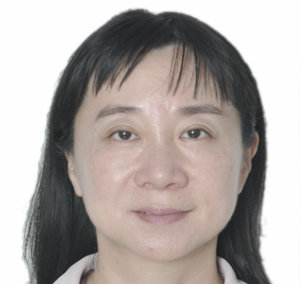ACUPUNCTURE
At Newleaf Total Wellness Centre, we harness the ancient Chinese tradition of Acupuncture Therapy to promote your overall well-being. Acupuncture is a powerful tool, tapping into the belief that our organ systems are interconnected through meridian energy pathways. Our skilled acupuncturists delicately work with fine needles to stimulate a natural healing response within your body. By targeting specific points along these meridians, we address any stagnation or blockages that may be causing pain, discomfort, disease, or emotional and spiritual imbalances. We aim to restore balance by increasing blood flow and circulation and providing much-needed relief through the art of acupuncture. Join us at Newleaf Total Wellness Centre and experience the transformative power of acupuncture and complementary therapies as we help you find balance, alleviate pain, and restore vitality.
Our skilled acupuncturists delicately work with fine needles to stimulate a natural healing response within your body. By targeting specific points along these meridians, we can address any stagnation or blockages that may be causing pain, discomfort, disease, or emotional and spiritual imbalances. We aim to restore balance by increasing blood flow and circulation and providing much-needed relief through the art of acupuncture.
Our treatments include Chinese Acupuncture, Cupping, Acupressure/Tui Na, Food Cure, and Herbal Therapy.
Join us at Newleaf Total Wellness Centre and embark on a journey towards holistic wellness. Experience the transformative power of acupuncture and complementary therapies as we help you find balance, alleviate pain, and restore vitality.
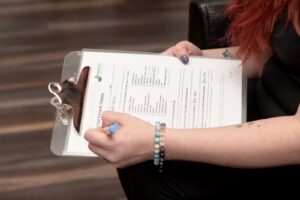
At Newleaf Total Wellness Centre, we prioritize your well-being by providing comprehensive and personalized acupuncture treatments. Our experienced acupuncturist will thoroughly assess your general health during your initial session to ensure the most effective treatment tailored to your needs.
To gain a holistic understanding of your condition, we will discuss various aspects of your health, including current symptoms, past treatments, family medical history, diet, digestive system, sleeping patterns, and emotional well-being.
In addition, we will carefully evaluate the pulse on both wrists to gain insights into the flow of energy within your body. Furthermore, the acupuncturist will analyze your tongue’s structure, colour, and coating as part of the diagnostic process.
During this comprehensive evaluation, our practitioner will also observe your emotions, voice, and self-presentation, as these factors contribute to the diagnosis and development of a treatment plan that aims to harmonize your overall energy. The practitioner will select specific acupuncture points and begin the treatment based on the gathered information.
To optimize your acupuncture experience, we provide the following tips:
- Refrain from brushing your teeth and tongue immediately before treatment to ensure an accurate tongue diagnosis, and avoid consuming beverages that may stain your tongue, such as coffee, gum, and candies.
- Remove all jewelry before the treatment to facilitate the administration of acupuncture.
- Visit the restroom before your session.
- Openly communicate with your acupuncturist, providing honest answers to their questions.
- Please remember that all information is kept confidential and helps with the diagnosis and treatment.
- Avoid consuming alcoholic beverages before and after treatment.
- Exercise caution after your session, as you may experience slight dizziness.
- Following the treatment, it is important to rest and relax for the remainder of the day.
- Refrain from vigorous exercise and minimize direct exposure to wind and cold.
Please note that slight bruises from the treatment may be visible, which is normal. Lastly, it is crucial to relax during your treatment. By allowing your mind and body to unwind, you will maximize the benefits of acupuncture.
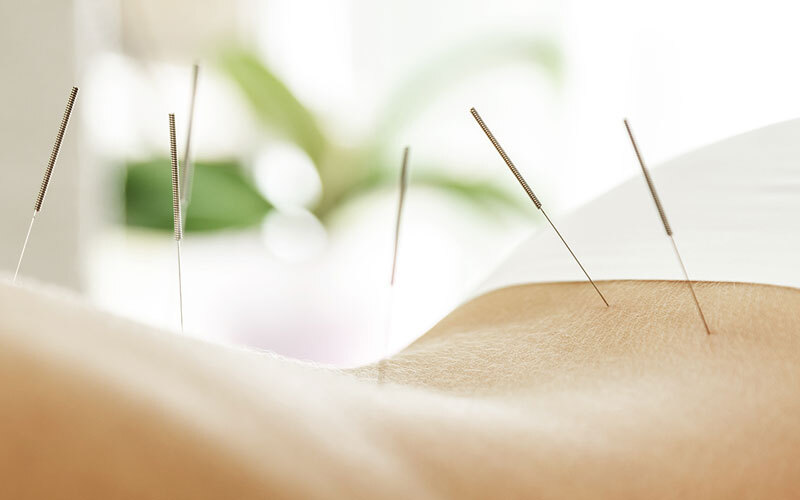
Acupuncture is generally a well-tolerated procedure, but it’s natural to wonder if it causes discomfort. The sensation experienced during acupuncture can vary depending on the length and diameter of the needles used. It’s worth noting that needle insertion may sometimes cause temporary pain. Particularly, if an acupuncture point on your body is energy deficient or overstimulated, discomfort may be associated with the insertion. Occasionally, when the needle is inserted slightly deeper, you may feel a sensation known as “de qi” or “grabbing the energy,” which can be perceived as a dull ache radiating along the acupuncture meridian.
What can you expect during an acupuncture session? Each acupuncture practitioner has a unique style, often incorporating elements from both Eastern and Western medicine. Your practitioner will inquire about your symptoms, behaviors, and lifestyle to determine the most suitable acupuncture treatment for you. They may also closely examine specific aspects, including the painful areas of your body, the shape, coating, and color of your tongue, the color of your face, and the strength, rhythm, and quality of your pulse in your wrist.
An acupuncture session can range up to 60 minutes, though some appointments may be shorter. A typical treatment plan for a specific condition usually involves one or two weekly sessions. The number of treatments required will depend on the condition’s nature and severity. As a general guideline, receiving 6 to 8 treatments is common.
Let’s delve into what happens during the procedure. Acupuncture points are located throughout the body, and sometimes the appropriate points for your treatment may be distant from where you experience pain. Your acupuncture practitioner will inform you about the general location of the planned treatment and if any clothing needs to be removed. You will receive a gown, towel, or sheet for coverage. During the treatment, you will lie on a padded table, and the procedure typically includes the following steps:
Needle insertion: Very thin Acupuncture needles are inserted at various depths into strategic points on your body. The insertion process is usually minimally discomforting; some people may not feel the needles inserted. A typical treatment utilizes 5 to 20 needles. You may experience a mild, achy sensation when a needle reaches the correct depth.
Needle manipulation: Your practitioner may gently manipulate or twirl the needles after placement, apply heat, or provide mild electrical pulses to enhance the therapeutic effect.
Needle removal: In most cases, the needles remain in place for 10 to 15 minutes while you lie and relax. The removal of the needles is typically painless.
After the acupuncture procedure, individuals may experience different responses. Some people feel relaxed, while others feel energized. However, it’s important to note that not everyone responds to acupuncture similarly. If your symptoms do not improve within a few weeks of treatment, acupuncture may not be the most effective approach for your situation.
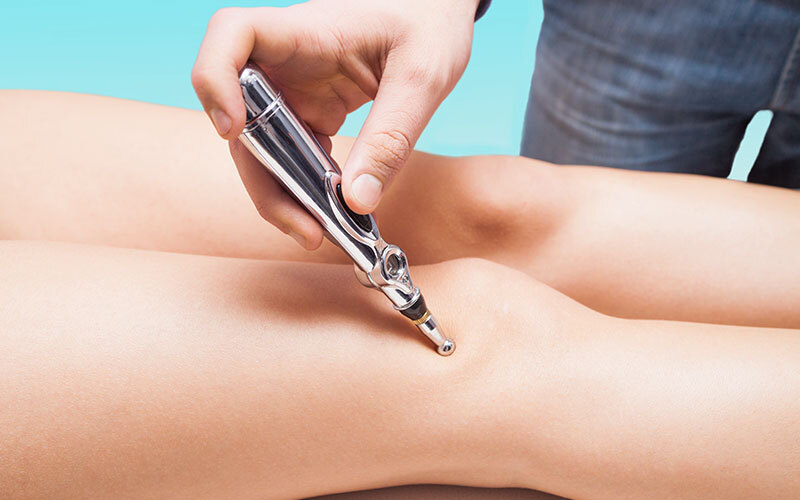
Fascinating Fact:
Did you know that LASER stands for Light Amplification by Stimulated Emission of Radiation? At Newleaf Total Wellness Centre, we harness the power of this special focused light energy to invigorate your body’s cells. The precisely aligned light used in Laser Therapy allows your body to absorb its energy effectively.
So, what exactly does Laser Therapy do?
Think of it as the Energizer Bunny for your cells. It provides them with an extra boost of energy through a process called photobiomodulation. Here’s how Laser Therapy can benefit you:
Stimulates collagen growth: This helps heal skin, muscles, ligaments, tendons, and bones by promoting fibroblastic activity.
Enhances wound healing: Laser Therapy increases blood flow to the affected area, aiding healing.
Alleviates pain: Laser Therapy has been shown to reduce pain, relieving various conditions.
What does Laser Therapy feel like?
You won’t experience tingling, buzzing, or heat sensations during the treatment. Instead, you’ll only feel the gentle pressure of the LASER device against your skin. Some patients have even noticed a mild warmth, adding to the comforting experience.
Which conditions can Laser Therapy help with?
Laser Therapy is versatile and can assist with a range of conditions, including:
- Muscle strains and tears
- Trigger points
- Ligament sprains
- Tendon conditions (e.g., tendonitis)
- Bursitis
- Arthritis
- Carpal Tunnel Syndrome
- Wound healing (reducing scarring)
- Nerve pain (Neuralgia)
- Acute pain
- Chronic Pain
- Chronic Joint Disorders
At Newleaf Total Wellness Centre, we’re dedicated to helping you find relief and rejuvenation through Laser Therapy. Our experienced team is here to guide you on your journey to wellness.
Are there risks to Laser Therapy?
LASERs have become ubiquitous in our modern world, finding applications in diverse areas such as laser pointers, grocery store scanners, and advanced medical devices. It’s important to note that when used by trained professionals who possess the necessary expertise, LASER technology is safe and effective.
Of course, your well-being is our utmost priority. Before any treatment involving LASER therapy, we will conduct a thorough assessment to ensure its suitability for you and discuss any potential risks associated with the procedure.
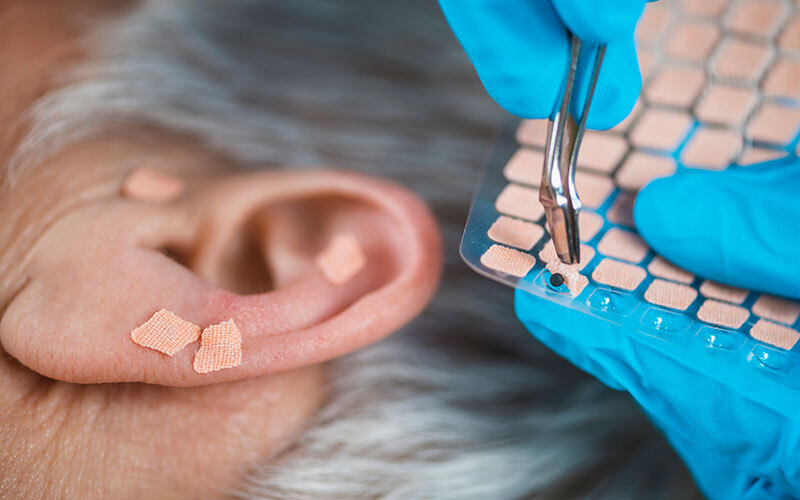
Ear seeding, or auricular acupuncture or auriculotherapy, is a traditional therapy deeply rooted in Traditional Chinese Medicine (TCM). It is considered a form of complementary and alternative medicine. The underlying principle of auriculotherapy is that the entire body and its systems, such as the reproductive, nervous, digestive, and respiratory systems, can be mapped onto the ear. This mapping is referred to as a microsystem.
Tiny metallic beads (or sometimes actual seeds, ceramic beads, or magnetic beads) are attached to small adhesive material like tape during an ear seeding session. These beads are strategically placed on specific points on the ear’s surface corresponding to various organs and systems in the body.
Following the placement of the beads, you will wear them for a duration determined by your acupuncturist. The beads provide continuous gentle stimulation to the corresponding ear points.
Ear seeding can be used to address a range of conditions, including:
- Allergies
- Anxiety
- Cancer and chemotherapy pain and side effects
- Chronic pain, especially in the lower back
- Depression
- Digestive issues
- Insomnia
- Migraine
- Pain and side effects associated with cancer and chemotherapy
- Substance use disorders
- Weight loss
By stimulating specific points on the ear, ear seeding promotes balance and harmony within the corresponding systems and organs of the body. It is a non-invasive and potentially beneficial therapy that can be used alongside other treatments to support overall well-being. Our skilled practitioners at Newleaf Total Wellness Centre can guide you through ear seeding and help determine if it suits your specific needs.
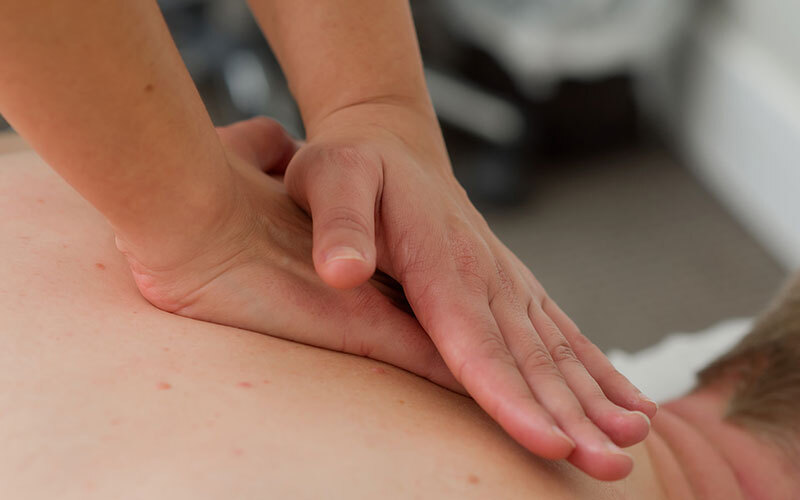
Tuina massage is a therapeutic practice that shares similarities with acupuncture, as it utilizes the same energy meridians and acupoints to restore balance to the flow of qi and blood in your body, promoting overall health. When qi flow is disrupted, it can lead to blockages and hinder proper blood circulation in the affected areas. The primary purpose of tuina massage is to address these energetic blockages, effectively alleviating qi stagnation.
During a tuina massage session, skilled practitioners employ oscillating and pressure techniques, varying in force and speed. The massage can range from a deeper, more intense deep-tissue treatment to a gentler, more energetic approach. Some techniques are considered more yin, characterized by gentleness, passivity, and meditative qualities. In contrast, others follow a yang approach, which is more active, dynamic, and physical, aiming to stimulate deep blockages and knots, resulting in more intense sensations.
Practitioners focus on massaging the muscles and tendons and utilizing manipulation techniques to realign the body. Passive joint movements are incorporated to restore muscle and joint function.
Depending on your specific needs, various techniques may be employed during a tuina massage session. Herbal poultices or compresses, lotions, and salves might be applied to enhance the therapeutic effects.
Tuina massage incorporates techniques such as acupressure, myofascial release, reflexology, and sometimes stretches and joint mobilizations commonly associated with osteopathy and chiropractic care.
There are eight fundamental techniques used in tuina massage, including palpating (mo), rejoining (jie), opposing (duan), lifting (ti), pressing (an), kneading (mo), pushing (tui), and holding (na).
Additional techniques utilized in tuina massage include rolling, which is effective for addressing injuries like sprains and strains, and the one-finger technique, involving targeted stimulation of acupressure points. Nei gung, a comprehensive full-body manipulation technique, may also be employed.
Our trained practitioners incorporate the art of tuina massage into our holistic approach, tailoring the treatment to your specific needs. Experience the healing benefits of tuina massage as we work together to restore balance, relieve discomfort, and enhance your overall well-being.
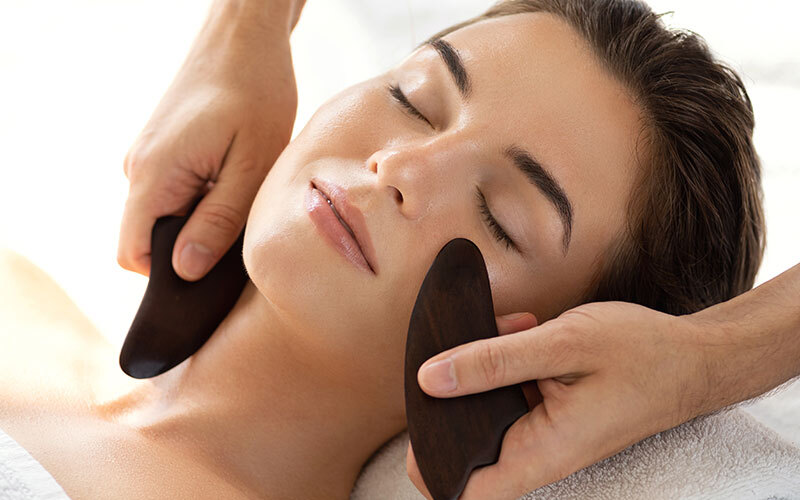
Gua Sha, known as skin scraping, spooning, or coining, is a traditional Chinese healing technique. During a Gua Sha treatment, pressure is applied to the skin using a massage tool, which results in scraping or stroking motions. This technique is renowned for relieving discomfort and tension associated with musculoskeletal pain. It may cause light bruising, manifesting as purple or red spots known as petechiae or sha.
In the context of traditional Chinese medicine, the body’s energy flow is referred to as qi or chi. Maintaining balanced and unobstructed qi flow is believed to be essential for overall health and well-being. Gua Sha addresses any blockages in the qi, which can cause muscle and joint pain or stress. By applying Gua Sha, it is believed that the blocked energy can be released, alleviating aches and stiffness. Another goal of Gua Sha is to address blood stasis or stagnation, as traditional East Asian medicine attributes pain and illness to stagnant blood. By performing Gua Sha, it is thought that pooled or stagnated blood can be moved and dispersed, reducing symptoms.
What can you expect during a Gua Sha treatment? The process typically involves the application of massage oil or lubricant to the designated area. A Gua Sha massage tool with a smooth edge is then used to perform short strokes or scraping motions on the skin. The intensity and duration of these strokes may vary depending on the specific procedure and practitioner. For example, bony areas may be treated more gently than flatter or muscular areas, such as the cervical spine in the neck. A Gua Sha session can take several minutes or longer to complete.
After the Gua Sha treatment, it is advisable to take it easy for the remainder of the day. It is recommended to avoid consuming alcohol, as it is believed that the benefits of the treatment may diminish if excessive activity is undertaken too soon. Resting and allowing the body to fully experience the effects of the Gua Sha session is encouraged. It’s worth noting that Gua Sha is often combined with other types of treatments, such as acupuncture, to enhance overall therapeutic outcomes.
Experience the benefits of this traditional Chinese technique as we work to alleviate discomfort and promote balance within your body. Rest assured that our dedicated team is committed to providing a comfortable and nurturing environment throughout your Gua Sha journey.
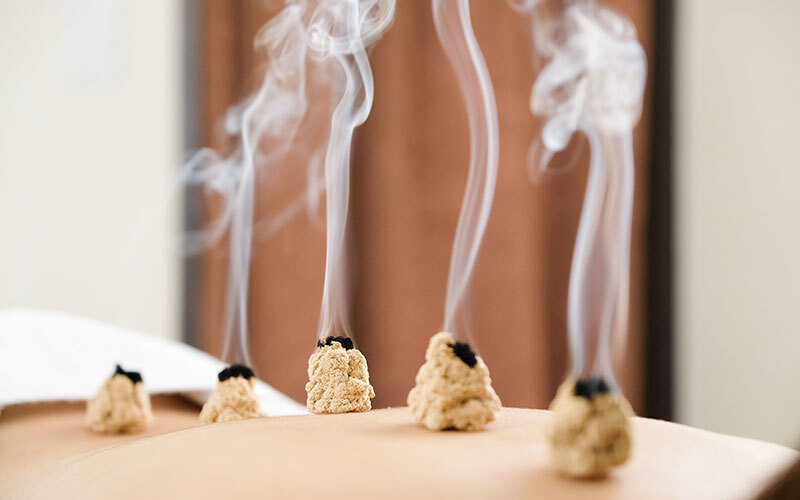
Moxibustion is a traditional Chinese therapy that involves the burning of the Chinese herb Artemisia vulgaris, commonly known as mugwort, a few centimeters above the skin’s surface. This technique is beneficial for warming cool bodies and increasing yang energy in the body.
Moxibustion is particularly useful in addressing various conditions, including digestive issues with cold symptoms, lumps in the skin, joint injuries, and even helping turn breech-positioned babies.
At our clinic, we utilize Infrared Moxibustion, which involves using moxibustion combined with infrared radiation. This process produces infrared radiation that can penetrate the tissues deeper than normal infrared radiation. The deeper penetration helps to stimulate cell growth by activating the protein complex activin, which promotes overall cellular health. Additionally, Infrared Moxibustion can boost the immune system, providing a positive impact on your well-being.
Another benefit of moxibustion is its ability to refresh the meridians in the body. Meridians are channels through which the chi energy flows, connecting different acupuncture points. By stimulating these meridians, moxibustion encourages the flow of chi, the vital life force energy. This therapy positively affects various acupuncture points, enhancing the flow and balance of chi throughout the body.
Chinese treatments, such as moxibustion, play a significant role in increasing chi and promoting overall well-being. By incorporating moxibustion into your personalized treatment plan, you can experience the rejuvenating effects on your body’s energy and enjoy the benefits of enhanced cellular growth and immune function.
Experience the healing power of moxibustion as we guide you on a journey toward improved vitality and balance. Trust in our expertise and commitment to your well-being as we integrate this traditional Chinese therapy into your holistic treatment approach.
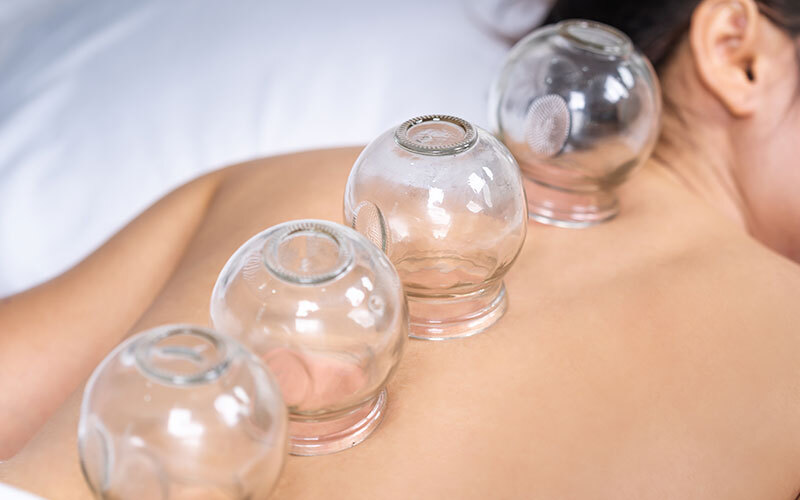
Cupping therapy, also known as cupping massage or myofascial decompression, is an ancient Chinese technique that involves placing specialized cups on specific areas of the skin to create suction. This alternative therapy has been historically used to complement traditional care for various chronic illnesses and conditions.
Cupping therapy gained attention in the mainstream media when Michael Phelps showcased bruising and redness on his back during the 2016 Olympics, which are expected side effects of a cupping therapy session.
Traditionally, cups were made of bamboo or ceramic, but modern cups are typically made of glass or rubber with a glass-like ball on top. The practitioner applies negative pressure to the soft tissues, creating suction that draws the skin and muscles upward into the cup. Before placement, the cups are often warmed. Once cooled, the suction effect begins.
Cupping therapy offers numerous benefits, particularly in alleviating symptoms of chronic illnesses and various health conditions. It is often used alongside traditional therapies, so it is crucial to inform your doctors about your plan to incorporate cupping therapy into your treatment.
The benefits of cupping therapy include the following:
- Promoting the uninterrupted flow of Qi (pronounced chi) throughout the body, revitalizing the body’s energy sources.
- Balancing the yin and yang energies in the body.
- Increasing blood circulation by clearing the blood vessels.
- Relieving muscle tension and promoting cellular repair to reduce tension.
- Directing more blood flow to specific areas to stimulate the healing process.
- Supplying vital nutrients and oxygen to the targeted areas.
- Drawing out metabolic by-products, such as ammonia, urea, uric acid, and creatinine, which can hinder healing and cause inflammation.
Cupping therapy can assist in managing various conditions, including:
- Arthritis and rheumatoid arthritis
- Back and neck pain
- Shoulder pain and knee pain
- Asthma
- Carpal tunnel syndrome
- Irritable bowel syndrome
- Headaches and migraines
- High blood pressure and blood circulation issues
We offer cupping therapy as part of our comprehensive approach to healing. Our experienced practitioners will guide you through the process, tailoring the treatment to address your needs. Discover the potential benefits of cupping therapy as we work together to support your well-being and alleviate symptoms.
NO CUPPING IN THESE AREAS:
While cupping therapy can provide numerous benefits, certain cases may not be recommended, or caution should be exercised. It’s important to consult with your practitioner if you have any of the following conditions:
Skin Lesions or Inflammation: Cupping should be avoided if you have existing skin lesions or inflammation in the treatment area.
Organ Failure: Individuals with renal, hepatic, and/or cardiac organ failure should refrain from cupping therapy.
Pacemakers: If you have a pacemaker or any other electronic medical devices, cupping therapy should be avoided due to the potential interference with these devices.
Hemophilia or Bleeding Disorders: Cupping may not be suitable for individuals with bleeding disorders such as hemophilia or other similar conditions.
Cancer: Individuals undergoing cancer treatment or with a history of cancer should avoid cupping therapy unless specifically recommended by their healthcare provider.
Varicose Veins and Spider Veins: Cupping should be avoided over areas with varicose veins or spider veins to prevent potential complications.
It’s important to exercise caution and have a discussion with your practitioner if you have any of the following conditions:
- Diabetes with complications or an acute infection
- Taking anticoagulant medication such as aspirin or warfarin
- Severe chronic diseases such as heart disease
- Pregnancy, within 6 weeks after giving birth, or menstruating
- Lymphedema or anemia
- Recent tattoos in the treatment area (localized)
- Recent blood donation or undergoing a medical procedure
By discussing your specific situation with your practitioner, they can provide personalized guidance and determine the most appropriate approach to your cupping therapy or suggest alternative treatments if necessary.


